A bubble level tool, also known as spirit level was invented in 1661 to properly level telescopes and leveling instruments.
It is a small but useful tool that can help eliminate minute errors that can translate into humongous faults on a large scale.
Here we will be talking specifically about scope bubble levels and their importance in deciding the accuracy of a scope-rifle setup. So let’s dive into this pool of information without wasting time.
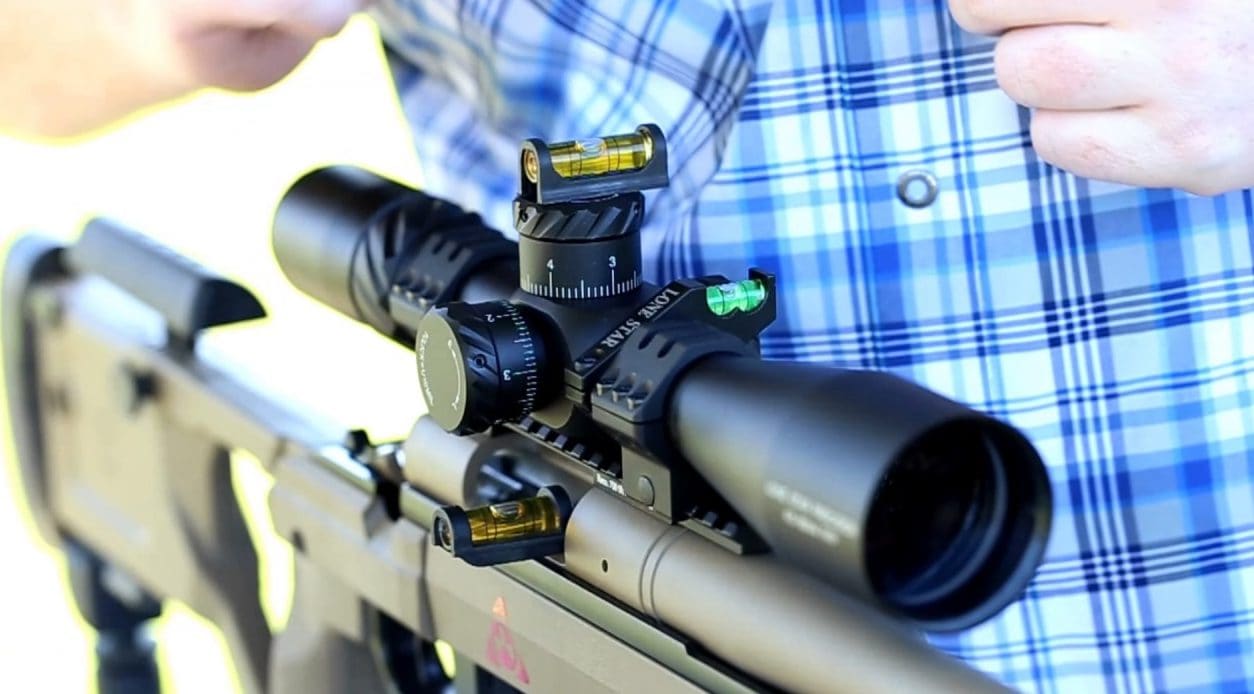
Photo credit: youtube.com
Scope Bubble Levels Terminology and Common Concepts
Before we push through the working, benefits, and drawbacks for a scope bubble level. It is better to understand some basic terminologies and concepts for better inference of the topic.
Cant Error
Also known as cant misalignment, this signifies that the scope alignment is tilted to the right or left from the central axis. Cant is a fancy term for tilt.
To understand the cant error in a simpler manner. Let’s take the help of an example. To shoot a target accurately, your line-of-sight should be properly aligned with the barrel. Now let’s assume that you are looking at the target through the scope mounted on your rifle. Where the scope is tilted at about 5 degrees clockwise to the barrel.
So when you shoot a bullet from the rifle, it will not impact the spot you are aiming for because this cant affects the bullet trajectory. Cant error expands exponentially as the shot distance increases.
Understand the concept better with this video:
Viscosity
This term refers to the level of resistance of a liquid against the flow. For example, water flows easily whereas sauce moves slower. Hence, the sauce is more viscous than water. Bubble levels use low viscosity liquids like ethanol. Often treated with a colorant for easy visibility.
Sensitivity
The movement of the bubble (right or left from the center position) in millimeters, relative to the angle of cant/tilt is called the sensitivity of a bubble level. This is directly related to the viscosity of the fluid used in the vial.
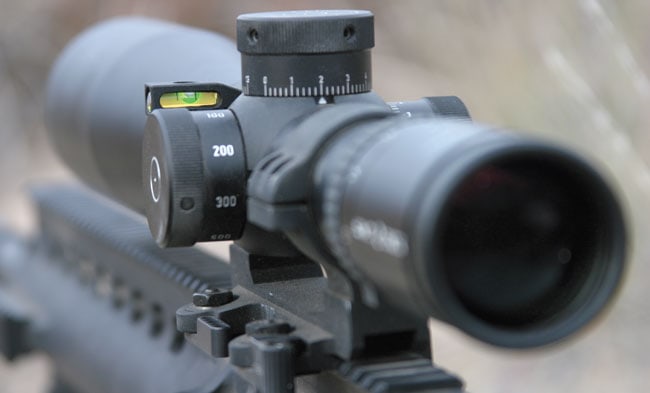
Photo credit: osgnetworks.tv
Hash Marks
This term is used to describe the vertical lines on the transparent vial of the scope level. The distance between these lines is generally the size of the bubble. These lines offer a reference point and also help the user estimate the amount of tilt and correct it accordingly.
Ring Size
Most scope bubble levels offer a ring that can be mounted over the scope. The size of this ring should be appropriate according to the size of the riflescope tube.
Plumb Line
A string with a plumb bob attached to it. A plumb bob is a piece of metal that when suspended through a point with this string, creates an absolute error free vertical line created under the influence of gravity.
How Does a Scope Bubble Level Work?
A scope bubble level helps with correcting the cant error on your rifle. Since the level helps you align your rifle and scope with the horizontal axis.
The bubble in the level is designed in such a manner that it stays right in the center of the vial when the level is in perfect perpendicular alignment with the horizontal axis. Since this level is mounted on the scope, which is further attached to the level. It helps bring the entire setup in perfect horizontal-vertical alignment. So your shots land exactly where you want to.
Canted scopes are a big reason to miss out on consistent shots on the long range. With the shooter not even knowing about it and blaming the wind, rifle, ammo, or other factors for this subpar performance.
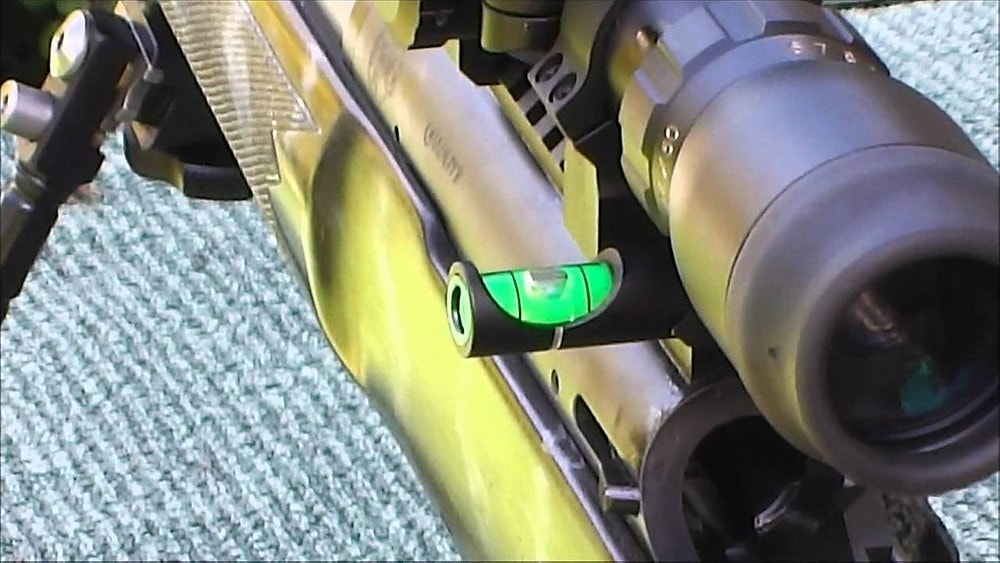
Photo credit: shootersden2.com
How to Install a Scope Bubble Level
Installing a scope bubble level on your rifle is a very easy process. All you need is a vise to clamp your rifle stably and a plumb line with a colored string. If you don’t have a vise, you can also use a bipod to stably position the rifle.
Also, ensure that it is a non-windy day or you are doing this activity indoors.
- Make sure the firearm is safe to use and void of any ammo.
- Mount the rifle on a vise or position it on the table using a bipod. Make sure that the scope is mounted on the rifle. Since it is the scope we’re gonna be leveling.
- Now take the plumb line and suspend it from a stable point at some distance from your rifle’s muzzle end. This distance can range between 50 to 100 yards.
- Look through the riflescope and try to align the vertical crosshair lines (aka stadia line) with the plumb line. So that it overlaps it. That’s the zero-cant position you want your scope to be leveled at.
- Now mount the bubble level onto your scope if you haven't already. Move the level clockwise or counterclockwise until the bubble is positioned in the center.
- Once the bubble reaches the central hashmark, tighten the level. That’s it!
One very important fact to note here is that some pro shooters keep their scopes canted a bit. In order to compensate for climatic factors. But that’s a different story altogether and suitable for a dedicated discussion.

Photo credit: riflescopescenter.com
How Does a Scope Bubble Level Help Exactly?
The answer to this question is pretty straightforward. Scope bubble levels are useful like the crosshairs on your scope. Suppose you are hunting in the woods and spot your quarry. But don’t find an exactly leveled horizontal rest to lean your rifle. This is the story almost 90% of the time when hunting.
Now, when you find an improvised rest, with or without a bipod on your rifle. You give a quick look at your scope bubble level and adjust the cant of your rifle. Ensuring that your bullet lands exactly where you want.
When shooting over a very long range (600 yards or more). Marksmen tend to check the level after every shot to ensure precision. This is especially useful when you are aiming for close groups over a long range.
Scope bubble levels are a necessity for long range shooters and snipers. That’s because the slightest two or three degree cant on the rifle can translate to a 20+ inches difference on the impact spot at 1,000 yards.
Pros of Scope Bubble Levels
After you’ve learned about the concept of a scope bubble level and why it is useful in certain situations. Let’s take a look at the benefits of using one on your rifle.
Consistent Long Range Accuracy
Scope bubble levels are an important tool when you are involved in long range marksmanship. There are a lot of factors that come into play when shooting over long distances. And the last thing you want to be interfering with your accuracy is a mispositioned scope.
That’s not only annoying but also irresponsible behavior that is not expected from a professional shooter. A scope bubble level becomes extremely important if you are a bench rest shooter.
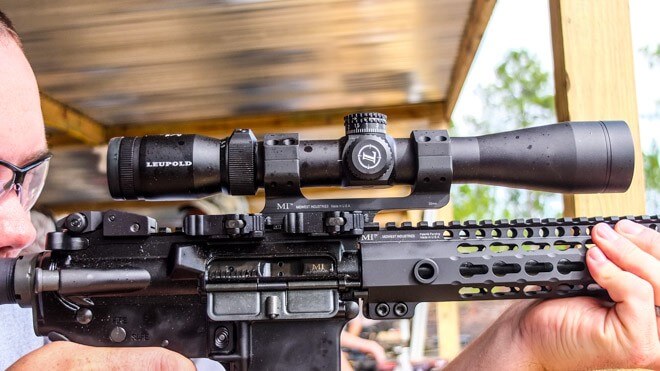
Photo credit: montemlife.com
Accurate On-the-Fly Adjustments
These bubble levels can be a very useful piece of equipment when you are out hunting with a bipod-mounted rifle. The bubble level will provide an instant reference to ensure you are shooting a cant-free shot. When you are leaning your rifle against an improvised platform.
There’ll be times when you’ll have to make quick follow up shots on an escaping game target. In such a situation when you have to quickly change your stance and shoot a target with constantly increasing distance. A scope bubble level will be a useful addition.
Inexpensive and Easy to Handle
A scope bubble level is not an expensive add-on for your rifle. But if used properly, it can let you use the most expensive rifles and scopes to their best potential. Most of these won’t even cost you more than $20. Plus, these can be easily mounted/dismounted and many designs allow you to quickly use your non-dominant eye without bringing your eyes off the target.
Cons of Scope Bubble Levels
Like every coin has two sides. Scope bubble levels also have a few cons associated with them. These may or may not concern your intended application. But will give you an overall view of the drawbacks.

Photo credit: youtube.com
Mostly Useful for Long Range Shooters
If your shooting range mostly stays within the 400-yard mark, and you are not using your rifles for competitive uses. A scope bubble level will not be a very important accessory for your rifle. Although it’s still a good add-on. But it is most beneficial for long range shooting applications.
Extra Weight and Some Obstruction
Bubble levels add a slight weight to the rifle. While it may not be much, when you have to carry your rifle over rugged mountainous terrain every extra ounce counts.
Apart from that, some bubble levels have a design that obstructs the vision and also when moving the rifle through thick brush. While the examples for such levels are very few. It is still something to keep an eye out for.
Alternatives to Scope Bubble Levels
Before we talk about alternatives to scope bubble levels. Let’s understand their one very important benefit.
Bubble levels have been around for a long time now and you can use a normal torpedo level to estimate the cant in your rifle/scope. But scope bubble levels can be mounted on the rifle which means that your level will always be by your side and ready to use.
There are scope bubble levels available in quite a few different designs. But as far as an alternative is concerned. These levels are pretty much unique for what they deliver.
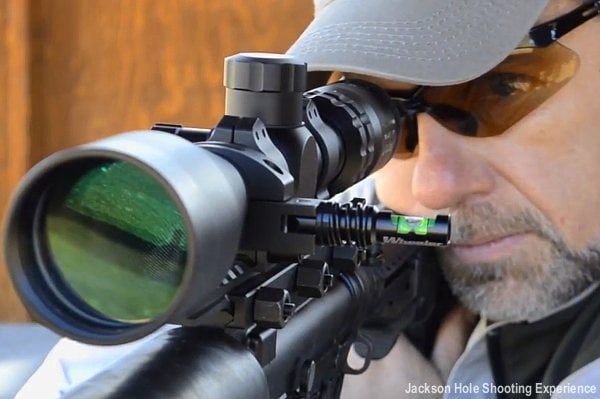
Photo credit: accurateshooter.com
Conclusion
A scope bubble level helps you ensure that your rifle and scope are perfectly aligned in the vertical axis and the rifle shoots precise tight groups. These levels are very crucial for long range shooting (>400 yards) because a small degree cant difference can end up in a POI shift for 5 inches at 1,000 yards.


